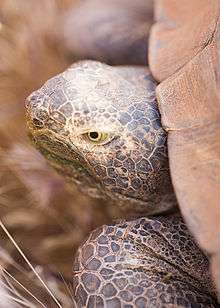Bell's hinge-back tortoise
Bell's hinge-back tortoise (Kinixys belliana)[1] is a species of African tortoise, from the family Testudinidae.[2] The genus was erected by John Edward Gray in 1831. It has the hinge that characterizes all tortoises in the genus Kinixys.
| Bell's hinge-back tortoise | |
|---|---|
 | |
| Kinixys belliana nogueyi | |
| Scientific classification | |
| Kingdom: | Animalia |
| Phylum: | Chordata |
| Class: | Reptilia |
| Order: | Testudines |
| Suborder: | Cryptodira |
| Superfamily: | Testudinoidea |
| Family: | Testudinidae |
| Genus: | Kinixys |
| Species: | K. belliana |
| Binomial name | |
| Kinixys belliana | |
| Synonyms[3] | |
| |
Etymology
Both the specific name, belliana, and the common name are in honor of English zoologist Thomas Bell.[4]
Description
Bell's hinge-back tortoise is a medium-sized light brown tortoise. They can grow up to 22 cm. On the back of its shell, the tortoise has a 90 degree hinge which, when closed, can protect its rear legs and tail from predators. This broad band of flexible connective tissue is located between the 4th and 5th costals and the 7th and 8th peripherals in adults.
The scutes on its slightly domed and elongated shell typically have a radiating pattern of dark patches, though these can fade. Adult males have a concave belly. Most Bell's hinge-backs have five claws on each forefoot.
Distribution and habitat
In its habitat, Bell's hinge-back tortoise favours tropical and sub-tropical savannahs of sub-Saharan Africa.
It was traditionally considered to be the most common and widespread hinge-back tortoise, found throughout a large part of sub-Saharan Africa such as in Sudan, Tanzania, the Democratic Republic of the Congo and down to southern Africa. However, a revision of the species advocated by Kindler et al. (2012) restricted it only to the central African populations, ranging from Angola to Burundi.[5]
Diet
Bell's hinge-back tortoise is an omnivore, with a very varied diet consisting mainly of a range of different plants, but also including insects and other meat.
It feeds on vegetables, twigs, roots, leaves, fruits, earthworms, snails, tadpoles and other small invertebrates.
Threats and conservation
In its natural habitat, its predators are leopards, hawks and eagles.
Currently it is mainly threatened by widespread collection from the wild for the illegal international trade in the species. It is also collected by local peoples for food and human population growth in the area is putting pressure on the species. Human-induced fire is also a threat.
As of March 22, 2000, the USDA has banned importation of the Bell's hinge-back tortoise, leopard tortoise and the African spurred tortoise.
Subspecies
No subspecies are currently recognized.[2] The following subspecies were formerly recognized:[1]
- K. b. belliana - Bell's hinge-back
- K. b. domerguei - Madagascan hinge-back
- K. b. nogeuyi - western hinge-back
- K. b. zombensis - southeastern hinge-back
Kindler et al. (2012) raised the subspecies K. b. zombensis (which they considered a senior synonym of K. b. domerguei) and K. b. nogeuyi to the ranks of separate species.[5]
Parasites of hinge-back tortoises
Kinixys tortoises play host to a number of ectoparasites (external) and endoparasites (internal) A survey (by Alan Probert & Clive Humphreys) of mixed captive K. spekii and K. belliana (mostly K. spekii) in Zimbabwe showed that ticks (Arachnida) and roundworms (Nematoda) of genera Angusticium, Atractis and Tachygontria infect these tortoises. This has been reported by others as well. However, some of the tiny roundworms (photographed under SEM) are very likely new species and as yet remain undescribed.
References
- Rhodin 2010, p. 000.130
- Kinixys belliana at the Reptarium.cz Reptile Database. Accessed 3 August 2019.
- Fritz, Uwe; Havaš, Peter (2007). "Checklist of Chelonians of the World" (PDF). Vertebrate Zoology. 57 (2): 285. ISSN 1864-5755. Archived from the original (PDF) on 2010-12-17. Retrieved 29 May 2012.
- Beolens, Bo; Watkins, Michael; Grayson, Michael (2011). The Eponym Dictionary of Reptiles. Baltimore: Johns Hopkins University Press. xiii + 296 pp. ISBN 978-1-4214-0135-5. (Kinixys belliana, p. 22).
- Kindler, Carolin; Branch, William R.; Hofmeyr, Margaretha D.; Maran, Jérôme; Široký, Pavel; Vences, Miguel; Harvey, James; Hauswaldt, Susanne J.; Schleicher, Alfred; Stuckas, Heiko; Fritz, Uwe (2012). "Molecular phylogeny of African hinge-back tortoises (Kinixys): implications for phylogeography and taxonomy (Testudines: Testudinidae)". Journal of Zoological Systematics and Evolutionary Research. 50 (3): 192–201. doi:10.1111/j.1439-0469.2012.00660.x.
- Smylie, A. Kinixys (Hinged-Back Tortoises). Gulf Coast Turtle and Tortoise Society.
- Hingeback Central. Kinixys belliana Bell's Hingeback Tortoise.
- Bibliography
- Rhodin, Anders G.J.; van Dijk, Peter Paul; Iverson, John B.; Shaffer, H. Bradley (2010-12-14). "Turtles of the World 2010 Update: Annotated Checklist of Taxonomy, Synonymy, Distribution and Conservation Status" (PDF). Archived from the original (PDF) on 2010-12-15. Retrieved 2010-12-15.

